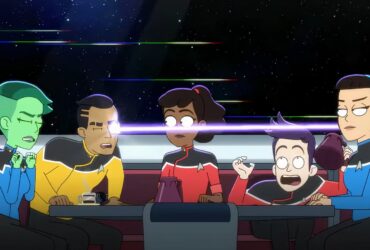When the crew of the Enterprise-D landed on the surface of Rubicun III and met the Edo, they were sure they’d encountered a true paradise. The planet was lush and verdant, with near perfect weather — sunny and warm all the time. The Edo were welcoming, friendly, and gorgeous. They greeted everyone with passionate hugs, and both men and women made enthusiastic sexual advances whenever another person seemed interested.
However, as is often the case in Star Trek, this paradise had darkness lurking right below the surface. The price of the Edo’s peaceful paradise was much higher than the crew of the Enterprise-D could have expected.

Related
The Most Beautiful Planets In The Star Trek Universe
These are some of the most beautiful planetary locations fans have had the chance to see in the Star Trek franchise’s universe.
The Edo’s Culture
As demonstrated by the way they greeted their visitors, the Edo’s culture was largely based around pleasure-seeking. They had sex whenever they wanted, with whoever they wanted, and spent much of their time kissing or giving and receiving sensual massages. When they weren’t seeking pleasure with each other, the Edo passed the time making music, dancing, and playing dice games or various sports.
Athleticism was a major part of Edo culture as well. Since their society was built around feeling good in their bodies, they placed a high priority on physical wellness. Instead of walking everywhere, they ran. They played lots of physical games together, and loved showing off their physical prowess.
Edo culture was also completely peaceful. Violence and crime were non-existent on the planet.
Their Draconic Law Enforcement
When Chief of Security Tasha Yar asked the leaders of the Edo how they had managed to completely eliminate crime on their planet, the leaders explained their unique, and extreme, justice system.
Law enforcement officers called Mediators randomly chose “punishment zones” each day. The citizenry never knew which part of the planet was a “punishment zone” at any given time. If someone committed a crime in a “punishment zone,” the Mediators would show up and gave them an injection of a lethal poison. In other words, the punishment for any crime, regardless of how minor, was death.
Ignorance of the “punishment zone” was not an excuse. In fact, not knowing where the “punishment zones” would be at any given time was part of why the system worked so effectively. No one risked committing a crime, because they never knew whether they were in a “punishment zone.”
This draconic system of law enforcement developed out of necessity, the Edo leaders explained. Their ancestors had lived in a chaotic world, filled with violence and crime, so they needed a drastic solution. Implementing the random “punishment zones” with the death penalty for any infraction eliminated crime completely within a generation.
The one thing they apparently hadn’t considered was that knowledge of their draconic law enforcement system was essential to its implementation. Wesley Crusher, who had come down to the Edo’s planet with his mother, accidentally committed the crime of disturbing a newly planted garden while in a “punishment zone.” When the Mediators arrived to administer the lethal injection, the Edo children he’d been playing with tried to explain that he was new to the planet and didn’t know about the laws. Though sympathetic, the Mediators insisted that the laws only worked if the death penalty was enforced for every crime.
Of course, the crew of the Enterprise-D was appalled by this judgment. But interfering with local law enforcement is considered a violation of the Prime Directive. After trying to get the Edo’s government to pardon Wesley and failing, Captain Picard made the decision to violate the Prime Directive to save Wesley’s life, and they all beamed back to the ship.
Abolishing Crime With Severe Punishment?
Star Trek often uses alien culture to examine controversial contemporary issues, and the Edo are a perfect example. In the 24th century envisioned by Gene Roddenberry, capital punishment was unthinkable. But in the 20th century world the episode premiered in, the death penalty was a hotly-debated issue. Star Trek: The Next Generation’s writers used the Edo to examine the issue without making it about the contemporary debate, though their position was clear.
As Captain Picard debated the Edo to try and save Wesley’s life, he used many of the arguments that opponents of the death penalty were making in the late 1980s. Picard explained that Earth also used capital punishment centuries ago, but found that it didn’t actually lower crime rates. He explained how his ancestors had learned that identifying the root causes of criminal behavior was much more effective than punishing criminal behavior. Once they were able to address the root causes of criminality, crime rates reduced drastically and capital punishment was abolished.
Though the Edo’s justification for their draconic law enforcement system made sense in theory, the episode demonstrated how all rigid systems of law enforcement lean toward injustice because of their refusal to take the circumstances into account. Presenting this perspective of criminal behavior and punishment as part of Earth’s history in the Star Trek universe was extremely progressive of TNG’s writers, coming decades before modern-day pushes to address the systemic causes of criminality rather than punishing criminals. As usual, the Star Trek universe gave people an ideal vision of the future to which they could aspire.

Star Trek: The Next Generation
- Release Date
- September 28, 1987
- Seasons
- 7
- Creator
- Gene Roddenberry
- Number of Episodes
- 178
Sources: Star Trek: The Next Generation episode “Justice”














Leave a Reply